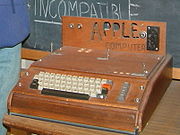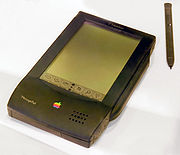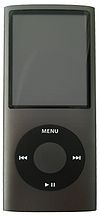
Apple Inc.
Background Information
This wikipedia selection has been chosen by volunteers helping SOS Children from Wikipedia for this Wikipedia Selection for schools. A good way to help other children is by sponsoring a child
| The Apple Logo | |
| Type | Public ( NASDAQ: AAPL, LSE: 0HDZ, FWB: APC) |
|---|---|
| Industry | Computer hardware · Computer software Consumer electronics · Digital distribution |
| Founded | Cupertino, California, United States (April 1, 1976) as Apple Computer, Inc. |
| Founder(s) | Steve Jobs, Steve Wozniak, Ronald Wayne |
| Headquarters | 1 Infinite Loop, Cupertino, California, USA |
| Number of locations | 251 (Q1 FY 2009) |
| Area served | Worldwide; United States, United Kingdom, Canada, Japan, Australia, Switzerland, Italy, Germany, and China |
| Key people | Steve Jobs ( CEO, Chairman, and Co-founder) Tim Cook ( COO) Peter Oppenheimer ( CFO) Phil Schiller ( SVP Marketing) Jonathan Ive (SVP Industrial Design) Mark Papermaster (SVP Device Engineering) Ron Johnson (SVP Retail) Sina Tamaddon (SVP Applications) Bertrand Serlet (SVP Software Engineering) Scott Forstall (SVP iPhone Software) |
| Products | Mac ( Pro, Mini · iMac · MacBook, Air, Pro · Xserve) iPhone, iPod ( Shuffle, Nano, Classic, Touch) Apple TV, Cinema Display, AirPort, Time Capsule Mac OS X ( Server · iPhone OS), iLife, iWork |
| Services | Stores ( retail, online, iTunes, App), MobileMe |
| Revenue | |
| Operating income | |
| Net income | |
| AUM | |
| Total assets | |
| Total equity | |
| Employees | 35,000 (Q1 FY 2009) |
| Subsidiaries | Braeburn Capital, FileMaker Inc. |
| Website | Apple.com |
Apple Inc. is an American multinational corporation that designs and manufactures consumer electronics and computer software products. The company's best-known hardware products include Macintosh computers, the iPod and the iPhone. Apple software includes the Mac OS X operating system, the iTunes media browser, the iLife suite of multimedia and creativity software, the iWork suite of productivity software, and Final Cut Studio, a suite of professional audio and film-industry software products. The company operates more than 250 retail stores in nine countries and an online store where hardware and software products are sold.
Established in Cupertino, California on April 1, 1976 and incorporated January 3, 1977, the company was called Apple Computer Inc. for its first 30 years, but dropped the word "Computer" on January 9, 2007 to reflect the company's ongoing expansion into the consumer electronics market in addition to its traditional focus on personal computers. Apple has about 35,000 employees worldwide and had worldwide annual sales of US$32.48 billion in its fiscal year ending September 29, 2008. For reasons as various as its philosophy of comprehensive aesthetic design to its distinctive advertising campaigns, Apple has established a unique reputation in the consumer electronics industry. This includes a customer base that is devoted to the company and its brand, particularly in the United States. Fortune magazine named Apple the most admired company in the United States in 2008 and in the world in 2009.
History
1976–1980: The early years
Apple was established on April 1, 1976 by Steve Jobs, Steve Wozniak, and Ronald Wayne, to sell the Apple I personal computer kit. They were hand-built by Wozniak and first shown to the public at the Homebrew Computer Club. The Apple I was sold as a motherboard (with CPU, RAM, and basic textual-video chips)—less than what is today considered a complete personal computer. The Apple I went on sale in July 1976 and was market-priced at $666.66.
Apple was incorporated January 3, 1977 without Wayne, who sold his share of the company back to Jobs and Wozniak for $800. Multi-millionaire Mike Markkula provided essential business expertise and funding of $250,000 during the incorporation of Apple.
The Apple II was introduced on April 16, 1977 at the first West Coast Computer Faire. It differed from its major rivals, the TRS-80 and Commodore PET, because it came with colour graphics and an open architecture. While early models used ordinary cassette tapes as storage devices, they were superseded by the introduction of a 5 1/4 inch floppy disk drive and interface, the Disk II.
The Apple II was chosen to be the desktop platform for the first " killer app" of the business world—the VisiCalc spreadsheet program. VisiCalc created a business market for the Apple II, and gave home users an additional reason to buy an Apple II—compatibility with the office. According to Brian Bagnall, Apple exaggerated its sales figures and was a distant third place to Commodore and Tandy until VisiCalc came along.
By the end of the 1970s, Apple had a staff of computer designers and a production line. The Apple II was succeeded by the Apple III in May 1980 as the company competed with IBM and Microsoft in the business and corporate computing market.
Jobs and several Apple employees including Jef Raskin visited Xerox PARC in December 1979 to see the Xerox Alto. Xerox granted Apple engineers three days of access to the PARC facilities in return for $1 million in pre- IPO Apple stock. Jobs was immediately convinced that all future computers would use a GUI, and development of a GUI began for the Apple Lisa.
In December 1980, Apple launched the Initial Public Offering of its stock to the investing public. When Apple went public, it generated more capital than any IPO since Ford Motor Company in 1956 and instantly created more millionaires (about 300) than any company in history. Several venture capitalists cashed out, reaping billions in long-term capital gains.
1981–85: Lisa and Macintosh
Steve Jobs began working on the Apple Lisa in 1978 but in 1982 he was pushed from the Lisa team due to infighting, and took over Jef Raskin's low-cost-computer project, the Macintosh. A turf war broke out between Lisa's "corporate shirts" and Jobs' "pirates" over which product would ship first and save Apple. Lisa won the race in 1983 and became the first personal computer sold to the public with a GUI, but was a commercial failure due to its high price tag and limited software titles.
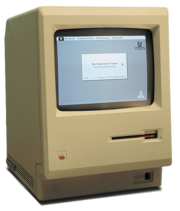
In 1984, Apple next launched the Macintosh. Its debut was announced by the now famous $1.5 million television commercial, " 1984". It was directed by Ridley Scott, aired during the third quarter of Super Bowl XVIII on January 22, 1984, and is now considered a watershed event for Apple's success and a "masterpiece".
The Macintosh initially sold well, but follow-up sales were not strong. The machine's fortunes changed with the introduction of the LaserWriter, the first PostScript laser printer to be offered at a reasonable price point, and PageMaker, an early desktop publishing package. The Mac was particularly powerful in this market due to its advanced graphics capabilities, which were already necessarily built-in to create the intuitive Macintosh GUI. It has been suggested that the combination of these three products was responsible for the creation of the desktop publishing market.
A power struggle developed between Jobs and new CEO John Sculley in 1985. Apple's board of directors sided with Sculley and Jobs was removed from his managerial duties. Jobs resigned from Apple and founded NeXT Inc. the same year.
Apple's sustained growth during the early 1980s was in great part due to its leadership in the education sector, attributed to an implementation of the LOGO Programming Language by Logo Computer Systems Inc., (LCSI), for the Apple II platform. The success of Apple and LOGO in the education environment provided Apple with a broad base of loyal users around the world. The drive into education was accentuated in California by a momentous agreement concluded between Steve Jobs and Jim Baroux of LCSI, agreeing with the donation of one Apple II and one Apple LOGO software package to each public school in the state. The arrangement, (eventually replicated in Texas), established a strong and pervasive presence for Apple in all schools throughout California, that ignited the acquisition of Apple IIs in schools across the country. The conquest of education became critical to Apple's acceptance in the home, as parents supported children’s continued learning experience after school.
1986–93: Rise and fall
Having learned several painful lessons after introducing the bulky Macintosh Portable in 1989, Apple introduced the PowerBook in 1991, which established the modern form and ergonomic layout of the laptop computer. The same year, Apple introduced System 7, a major upgrade to the operating system, which added colour to the interface and introduced new networking capabilities. It remained the architectural basis for Mac OS until 2001.
The success of the PowerBook and other products led to increasing revenue. For some time, it appeared that Apple could do no wrong, introducing fresh new products and generating increasing profits in the process. The magazine MacAddict named the period between 1989 and 1991 as the "first golden age" of the Macintosh.
Following the success of the LC, Apple introduced the Centris line, a low end Quadra offering, and the ill-fated Performa line that was sold in several confusing configurations and software bundles to avoid competing with the various consumer outlets such as Sears, Price Club, and Wal-Mart, the primary dealers for these models. The end result was disastrous for Apple as consumers did not understand the difference between models.
During this time Apple experimented with a number of other failed consumer targeted products including digital cameras, portable CD audio players, speakers, video consoles, and TV appliances. Enormous resources were also invested in the problem-plagued Newton division based on John Sculley's unrealistic market forecasts. Ultimately, all of this proved be too-little-too-late for Apple as their market share and stock prices continued to slide.
Apple saw the Apple II series as too expensive to produce, while taking away sales from the low end Macintosh. In 1990 Apple released the Macintosh LC with a single expansion slot for the Apple IIe Card to migrate Apple II users to the Macintosh platform. Apple stopped selling the Apple IIe in 1993.
Microsoft continued to gain market share with Windows, focusing on delivering software to cheap commodity personal computers while Apple was delivering a richly engineered, but expensive, experience. Apple relied on high profit margins and never developed a clear response. Instead they sued Microsoft for using a graphical user interface similar to the Apple Lisa in Apple Computer, Inc. v. Microsoft Corporation. The lawsuit dragged on for years before being thrown out of court. At the same time, a series of major product flops and missed deadlines destroyed Apple's reputation and Sculley was replaced by Michael Spindler.
1994–1997: Attempts at reinvention
By the early 1990s, Apple was developing alternative platforms to the Macintosh, such as the A/UX. The Macintosh platform was becoming outdated since it was not built for multitasking, and several important software routines were programmed directly into the hardware. In addition, Apple was facing competition from OS/2 and UNIX vendors like Sun Microsystems. The Macintosh would need to be replaced by a new platform, or reworked to run on more powerful hardware.
In 1994, Apple allied with IBM and Motorola in the AIM alliance. The goal was to create a new computing platform (the PowerPC Reference Platform), which would use IBM and Motorola hardware coupled with Apple's software. The AIM alliance hoped that PReP's performance and Apple's software would leave the PC far behind, thus countering Microsoft. The same year, Apple introduced the Power Macintosh, the first of many Apple computers to use IBM's PowerPC processor.
In 1996, Michael Spindler was replaced by Gil Amelio as CEO. Gil Amelio made many changes at Apple, including massive layoffs. After multiple failed attempts to improve Mac OS, first with the Taligent project, then later with Copland and Gershwin, Amelio chose to purchase NeXT and its NeXTSTEP operating system, bringing Steve Jobs back to Apple as an advisor. On July 9, 1997, Gil Amelio was ousted by the board of directors after overseeing a three-year record-low stock price and crippling financial losses. Jobs became the interim CEO and began restructuring the company's product line.
At the 1997 Macworld Expo, Steve Jobs announced that Apple would join Microsoft to release new versions of Microsoft Office for the Macintosh, and that Microsoft made a $150 million investment in non-voting Apple stock.
On November 10, 1997, Apple introduced the Apple Store, tied to a new build-to-order manufacturing strategy.
1998–2005: Return to profitability
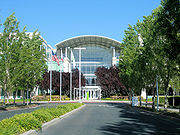
On August 15, 1998, Apple introduced a new all-in-one computer reminiscent of the Macintosh 128K: the iMac. The iMac design team was led by Jonathan Ive, who would later design the iPod and the iPhone. The iMac featured modern technology and a unique design. It sold close to 800,000 units in its first five months and returned Apple to profitability for the first time since 1993.
Through this period, Apple purchased several companies to create a portfolio of professional and consumer-oriented digital production software. In 1998, Apple announced the purchase of Macromedia's Final Cut software, signaling its expansion into the digital video editing market. The following year, Apple released two video editing products: iMovie for consumers, and Final Cut Pro for professionals, the latter of which has gone on to be a significant video-editing program, with 800,000 registered users in early 2007. In 2002 Apple purchased Nothing Real for their advanced digital compositing application Shake, as well as Emagic for their music productivity application Logic, which led to the development of their consumer-level GarageBand application. iPhoto's release the same year completed the iLife suite.
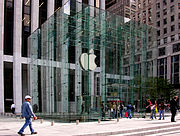
Mac OS X, based on NeXT's OPENSTEP and BSD Unix was released on March 24, 2001, after several years of development. Aimed at consumers and professionals alike, Mac OS X aimed to combine the stability, reliability and security of Unix with the ease of use afforded by an overhauled user interface. To aid users in migrating from Mac OS 9, the new operating system allowed the use of OS 9 applications through Mac OS X's Classic environment.
On May 19, 2001, Apple opened the first official Apple Retail Stores in Virginia and California. The same year, Apple introduced the iPod portable digital audio player. The product was phenomenally successful — over 100 million units were sold within six years. In 2003, Apple's iTunes Store was introduced, offering online music downloads for $0.99 a song and integration with the iPod. The service quickly became the market leader in online music services, with over 5 billion downloads by June 19, 2008.
Since 2001 Apple's design team has progressively abandoned the use of translucent colored plastics first used in the iMac G3. This began with the titanium PowerBook and was followed by the white polycarbonate iBook and the flat-panel iMac.
2005–present: The Intel partnership
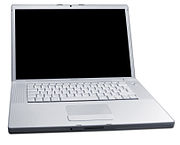
At the Worldwide Developers Conference keynote address on June 6, 2005, Steve Jobs announced that Apple would begin producing Intel-based Mac computers in 2006. On January 10, 2006, the new MacBook Pro and iMac became the first Apple computers to utilize Intel's Core Duo CPU. By August 7, 2006 Apple had transitioned the entire Mac product line to Intel chips, over 1 year sooner than announced. The Power Mac, iBook, and PowerBook brands were retired during the transition; the Mac Pro, MacBook, and MacBook Pro became their respective successors.. On April 29, 2009, The Wall Street Journal reported that Apple was building its own team of engineers to design microchips.
Apple also introduced Boot Camp to help users install Windows XP or Windows Vista on their Intel Macs alongside Mac OS X.
Apple's success during this period was evident in its stock price. Between early 2003 and 2006, the price of Apple's stock increased more than tenfold, from around $6 per share (split-adjusted) to over $80. In January 2006, Apple's market cap surpassed that of Dell. Nine years prior, Dell's CEO Michael Dell said that if he ran Apple he would "shut it down and give the money back to the shareholders."
Delivering his keynote at the Macworld Expo on January 9, 2007, Steve Jobs announced that Apple Computer, Inc. would from that point on be known as Apple Inc. The event also saw the announcement of the iPhone and the Apple TV. The following day, Apple shares hit $97.80, an all-time high. In May, Apple's share price passed the $100 mark.
On February 6, 2007, Apple indicated that it would sell music on the iTunes Store without DRM (which would allow tracks to be played on third-party players) if record labels would agree to drop the technology. On April 2, 2007, Apple and EMI jointly announced the removal of DRM technology from EMI's catalog in the iTunes Store, effective in May.
On July 11, 2008, Apple launched the App Store to sell third-party applications for the iPhone and iPod Touch. Within a month, the store sold 60 million applications and brought in $1 million daily on average, with Steve Jobs speculating that the App Store could become a billion-dollar business for Apple. Three months later, it was announced that Apple had become the third-largest mobile handset supplier in the world due to the popularity of the iPhone.
On December 16, 2008, Apple announced 2009 would be the last year Apple would be attending the Macworld Expo, and that Phil Schiller would deliver the 2009 keynote in lieu of the expected Steve Jobs.
On January 14, 2009, an internal Apple memo from Steve Jobs announced that he would be taking a six-month leave of absence, until the end of June 2009, to allow him to better focus on his health and to allow the company to better focus on its products. Despite Steve Jobs' absence, Apple recorded its best non-holiday quarter (Q1 FY 2009) during the recession with a revenue of $8.16 billion and a profit of $1.21 billion.
Current products
Mac and accessories
- Mac mini, consumer sub-desktop computer introduced in January 2005.
- iMac, consumer all-in-one desktop computer that was first introduced by Apple in 1998. Its popularity helped revive the company's fortunes.
- Mac Pro, workstation-class desktop computer introduced in August 2006, it was previously known as the PowerMac.
- MacBook, consumer notebook introduced in 2006, available in white, it was previously known as the iBook.
- MacBook Air, ultra-thin, ultra-portable notebook, introduced in January 2008.
- MacBook Pro, professional portable computer alternative to the MacBook, available in 13, 15, and 17 inch variants, introduced in January 2006, it was previously known as the PowerBook.
- Xserve, rack mounted, dual or quad core, dual processor 1U server.
Apple sells a variety of computer accessories for Mac computers including the AirPort wireless networking products, Time Capsule, Cinema Display, Mighty Mouse, the Apple Wireless Keyboard computer keyboard, and the Apple USB Modem.
iPod
On October 23, 2001, Apple introduced the iPod digital music player. It has evolved to include various models targeting the needs of different users. The iPod is the market leader in portable music players by a significant margin, with more than 100 million units shipped as of April 9, 2007. Apple has partnered with Nike to offer the Nike+iPod Sports Kit enabling runners to synchronize and monitor their runs with iTunes and the Nike+ website. Apple currently sells four variants of the iPod.
- iPod Classic (previously named iPod from 2001 to 2007), portable media player first introduced in 2001, currently available in an 120 GB model.
- iPod Nano, portable media player first introduced in 2005, currently available in 8 and 16 GB models.
- iPod Shuffle, digital audio player first introduced in 2005, currently available in 1 and 4 GB models.
- iPod Touch, portable media player first introduced in September 2007, currently available in 8, 16, and 32 GB models.
iPhone
At the Macworld Conference & Expo in January 2007, Steve Jobs revealed the long anticipated iPhone, a convergence of an Internet-enabled smartphone and iPod. The original iPhone combined a 2.5G quad band GSM and EDGE cellular phone with features found in hand held devices, running a scaled-down versions of Apple's Mac OS X (dubbed iPhone OS), with various Mac OS X applications such as Safari and Mail. It also includes web-based and Dashboard apps such as Google Maps and Weather. The iPhone features a 3.5-inch (89 mm) touch screen display, 4, 8, or 16 GB of memory, Bluetooth, and Wi-Fi (both "b" and "g"). The iPhone first became available on June 29, 2007 for $499 (4 GB) and $599 (8 GB) with an AT&T contract. On June 9, 2008, at WWDC 2008, Steve Jobs announced that the iPhone 3G would be available on July 11, 2008. This version added support for 3G networking, assisted-GPS navigation, and a price cut to $199 for the 8 GB version, and $299 for the 16 GB version, which was available in both black and white. The new version was visually different from its predecessor in that it eliminated the flat silver back, and large antenna square for a curved glossy black or white back. Following complaints from many people, the headphone jack was changed from a recessed jack to a flush jack to be compatible with more styles of headphones. The software capabilities changed as well, with the release of the new iPhone came the release of Apple's App Store; the store provided applications for download that were compatible with the iPhone. On April 24, 2009, the App Store surpassed one billion downloads. On June 8, 2009, at Apple's annual worldwide developers conference, the iPhone 3GS was announced, providing an incremental update to the device including faster internal components, support for faster 3G speeds and video recording capability.
- iPhone 3G, currently available in an 8 GB model.
- iPhone 3GS, currently available in 16 and 32 GB models.
Apple TV
At the 2007 Macworld conference, Jobs demonstrated the Apple TV, (previously known as the iTV), a set-top video device intended to bridge the sale of content from iTunes with high-definition televisions. The device links up to a user's TV and syncs, either via Wi-Fi or a wired network, with one computer's iTunes library and streams from an additional four. The Apple TV originally incorporated a 40 GB hard drive for storage, includes outputs for HDMI and component video, and plays video at a maximum resolution of 720p. On May 31, 2007 a 160 GB drive was released alongside the existing 40 GB model and on January 15, 2008 a software update was released, which allowed media to be purchased directly from the Apple TV.
Software
Apple develops its own operating system to run on Macs, Mac OS X, the latest version being Mac OS X v10.6 Snow Leopard. Apple also independently develops computer software titles for its Mac OS X operating system. Much of the software Apple develops is bundled with its computers. An example of this is the consumer-oriented iLife software package that bundles iDVD, iMovie, iPhoto, iTunes, GarageBand, and iWeb. For presentation, page layout and word processing, iWork is available, which includes Keynote, Pages, and Numbers. iTunes, QuickTime media player, Safari web browser, and Software Update are available as free downloads for both Mac OS X and Windows.
Apple also offers a range of professional software titles. Their range of server software includes the operating system Mac OS X Server; Apple Remote Desktop, a remote systems management application; WebObjects, Java EE Web application server; and Xsan, a Storage Area Network file system. For the professional creative market, there is Aperture for professional RAW-format photo processing; Final Cut Studio, a video production suite; Logic, a comprehensive music toolkit and Shake, an advanced effects composition program.
Apple also offers online services with MobileMe (formerly .Mac) that bundles personal web pages, email, Groups, iDisk, backup, iSync, and Learning Centre online tutorials. MobileMe is a subscription-based internet suite that capitalizes on the ability to store personal data on an online server and thereby keep all web-connected devices in sync. Announced at MacWorld Expo 2009, iWork.com allows iWork users to upload documents for sharing and collaboration.
Timeline of Apple Inc. products
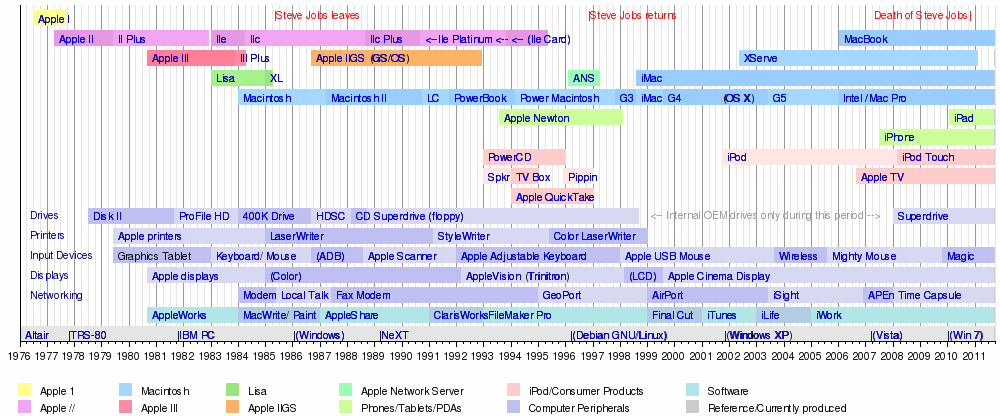
- Products on this timeline indicate introduction dates only and not necessarily discontinued dates, as new products begin on a contiguous product line.
Culture
Corporate
Apple was one of several highly successful companies founded in the 1970s that bucked the traditional notions of what a corporate culture should look like in terms of organizational hierarchy (flat versus tall, casual versus formal attire, etc.). Other highly successful firms with similar cultural aspects from the same time period include Southwest Airlines and Microsoft. Originally, the company stood in opposition to staid competitors like IBM more or less by default, thanks to the influence of its founders; Steve Jobs often walked around the office barefoot even after Apple was a Fortune 500 company. By the time of the "1984" TV ad, this trait had become a key way the company attempts differentiated itself from its competitors.
As the company has grown and been led by a series of chief executives, each with his own idea of what Apple should be, some of its original character has arguably been lost, but Apple still has a reputation for fostering individuality and excellence that reliably draws talented people into its employ, especially after Jobs' return. To recognize the best of its employees, Apple created the Apple Fellows program. Apple Fellows are those who have made extraordinary technical or leadership contributions to personal computing while at the company. The Apple Fellowship has so far been awarded to a few individuals including Bill Atkinson, Steve Capps, Rod Holt, Alan Kay, Guy Kawasaki, Al Alcorn, Don Norman, Rich Page, and Steve Wozniak.
Users
According to surveys by J. D. Power, Apple has the highest brand and repurchase loyalty of any computer manufacturer. While this brand loyalty is considered unusual for any product, Apple appears not to have gone out of its way to create it. At one time, Apple evangelists were actively engaged by the company, but this was after the phenomenon was already firmly established. Apple evangelist Guy Kawasaki has called the brand fanaticism "something that was stumbled upon". Apple has, however, supported the continuing existence of a network of Mac User Groups in most major and many minor centers of population where Mac computers are available.
Mac users meet at the European Apple Expo and the San Francisco Macworld Conference & Expo trade shows where Apple traditionally introduced new products each year to the industry and public. Mac developers in turn gather at the annual Apple Worldwide Developers Conference.
Apple Store openings can draw crowds of thousands, with some waiting in line as much as a day before the opening or flying in from other countries for the event. The New York City Fifth Avenue "Cube" store had a line as long as half a mile; a few Mac fans took the opportunity of the setting to propose marriage. The Ginza opening in Tokyo was estimated in the thousands with a line exceeding eight city blocks.
John Sculley told The Guardian newspaper in 1997: "People talk about technology, but Apple was a marketing company. It was the marketing company of the decade."
Market research indicates that Apple draws its customer base from an unusually artistic, creative, and well-educated population, which may explain the platform’s visibility within certain youthful, avant-garde subcultures.
Corporate affairs
Apple has a history of vertical integration in their products, manufacturing the hardware on which they pre-install their software.
During the Mac's early history Apple generally refused to adopt prevailing industry standards for hardware, instead creating their own. This trend was largely reversed in the late 1990s beginning with Apple's adoption of the PCI bus in the 7500/ 8500/ 9500 Power Macs. Apple has since adopted USB, AGP, HyperTransport, Wi-Fi, and other industry standards in its computers and was in some cases a leader in the adoption of such standards such as USB. FireWire is an Apple-originated standard that has seen widespread industry adoption after it was standardized as IEEE 1394.
Ever since the first Apple Store opened, Apple has sold third party accessories. This allows, for instance, Nikon and Canon to sell their Mac-compatible digital cameras and camcorders inside the store. Adobe, one of Apple's oldest software partners, also sells its Mac-compatible software, as does Microsoft, who sells Microsoft Office for the Mac. Books from John Wiley & Sons, who publishes the For Dummies series of instructional books, are a notable exception however. The publisher's line of books were banned from Apple Stores in 2005 because Steve Jobs disagreed with their editorial policy.
Headquarters
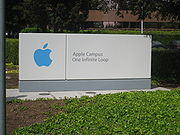
Apple Inc.'s world corporate headquarters are located in the middle of Silicon Valley, at 1 Infinite Loop, Cupertino, California. This Apple campus has six buildings that total 850,000 square feet (79,000 m2) and was built in 1993 by Sobrato Development Cos.
In 2006, Apple announced its intention to build a second campus on 50 acres (200,000 m2) assembled from various contiguous plots. The new campus, also in Cupertino, will be about one mile (1.6 km) east of the current campus.
CEOs
- 1977–1981: Michael "Scotty" Scott
- 1981–1983: A. C. "Mike" Markkula
- 1983–1993: John Sculley
- 1993–1996: Michael Spindler
- 1996–1997: Gil Amelio
- 1997-present: Steve Jobs (Interim CEO 1997–2000)
Directors
- Bill Campbell, Chairman of Intuit Inc.
- Millard Drexler, Chairman and CEO of J.Crew
- Al Gore, Former Vice President of the United States
- Steve Jobs, CEO and Co-founder of Apple; also a director of The Walt Disney Company
- Andrea Jung, Chairman and CEO of Avon Products
- Arthur D. Levinson, Chairman and CEO of Genentech
- Eric E. Schmidt, Chairman and CEO of Google
- Jerry York, Chairman, President, and CEO of Harwinton Capital
Executives
- Steve Jobs, Chief Executive Officer
- Timothy D. Cook, Chief Operating Officer
- Peter Oppenheimer, Chief Financial Officer
- Philip W. Schiller, Senior Vice President of Worldwide Product Marketing
- Mark Papermaster, Senior Vice President of Devices Hardware Engineering
- Jonathan Ive, Senior Vice President of Industrial Design
- Bertrand Serlet, Senior Vice President of Software Engineering
- Ron Johnson, Senior Vice President of Retail
- Sina Tamaddon, Senior Vice President of Applications
- Scott Forstall, Senior Vice President of iPhone Software
- Bob Mansfield, Senior Vice President Mac Hardware
- Daniel Cooperman, General Counsel and Secretary
Employees
Since formation of the Apple Computer Company in 1977, it (as Apple Computer, Inc.) has employed over 75,000 people worldwide. The majority of Apple's employees have been located in the United States but Apple has substantial manufacturing, sales, marketing, and support organizations worldwide, with some engineering operations in Paris and Tokyo.
Apple employees include employees of companies acquired by Apple as well as subsidiaries such as FileMaker Inc. and Braeburn Capital.
Advertising
Since the introduction of the Macintosh in 1984 with the 1984 Super Bowl commercial to the more modern ' Get a Mac' adverts, Apple has been recognized in the past for its efforts towards effective advertising and marketing for its products, though it has been criticized for the claims of some more recent campaigns, particularly 2005 Power Mac ads and iPhone ads in Britain.
Logos
Apple’s first logo, designed by Jobs and Wayne, depicts Sir Isaac Newton sitting under an apple tree. Almost immediately, though, this was replaced by Rob Janoff’s “rainbow Apple”, the now-familiar rainbow-colored silhouette of an apple with a bite taken out of it. Janoff presented Jobs with several different monochromatic themes for the "bitten" logo, and Jobs immediately took a liking to it. While Jobs liked the logo, he insisted it be in colour, as a way to humanize the company.
The original hand drawn logo features Sir Isaac Newton, and one theory states that the symbol references his discoveries of gravity (the apple) and the separation of light by prisms (the colors). Another explanation exists that the bitten apple pays homage to the mathematician Alan Turing, who committed suicide by eating an apple he had laced with cyanide. Turing is regarded as one of the fathers of the computer. The rainbow colors of the logo are rumored to be a reference to the rainbow flag, as a homage to Turing's homosexuality.
In 1998, with the roll out of the new iMac, Apple discontinued the rainbow theme — supposedly at the insistence of recently returned Jobs — and began to use monochromatic themes, nearly identical in shape to its previous rainbow incarnation. However, no specific colour is prescribed throughout Apple's software and hardware line. The logo's shape is one of the most recognized brand symbols in the world, identifies all Apple products and retail stores (the name "Apple" is not even present) and has been included as stickers in nearly all Macintosh and iPod packages through the years.
-
The original Apple logo featuring Isaac Newton under the fabled apple tree.
-
Apple Computer Logo.svg
The rainbow "bitten" logo, used from late 1976 until replaced in 1998 by monochrome themes.
-
Apple.svg
The monochrome-themed logo maintained the same shaped as the rainbow theme it replaced. It is still used and often appears in various colors on various products, such as packaging and advertisements in 2003.
-
Applelogo.svg
The Aqua-themed Apple logo, used from 2001 to 2003 on packaging and advertisements, and on early versions of Mac OS X before Panther.
-
Apple-logo.png
The "glass"-themed Apple logo, used from 2003 to present. It first appears on Mac OS X Panther and also on start-up of the iPhone, iPod Touch, fifth generation video iPod, iPod Nano, and all subsequent versions of these products.
Slogans
Apple's first slogan, " Byte into an Apple", was coined in the late 1970s. From 1997–2002, Apple used the slogan Think Different in advertising campaigns. The slogan had a lasting impact on their image and revived their popularity with the media and customers. Although the slogan has been retired, it is still closely associated with Apple. Apple also has slogans for specific product lines — for example, "iThink, therefore iMac", was used in 1998 to promote the iMac, and "Say hello to iPhone" has been used in iPhone advertisements. "Hello" was also used to introduce the original Macintosh, Newton, iMac ("hello (again)"), and iPod.
Commercials
Apple’s product commercials are notorious for launching musicians into stardom as a result of their eye-popping graphics and catchy tunes. First, the company popularized Canadian singer Feist’s “ 1234” song in its ad campaign. Then Apple used the song “ New Soul” by French-Israeli singer-songwriter Yael Naim to promote the MacBook Air. The debut single shot to the top of the charts and sold hundreds of thousands of copies in a span of weeks.
Environmental record
Greenpeace, an environmentalist organization, has confronted Apple on various environmental issues, including promoting a global end-of-life take-back plan, non-recyclable hardware components, and toxins within the iPhone hardware. Since 2003 they have campaigned against Apple regarding their chemical policies, in particular the inclusion of PVC and BFRs in their products, both of which have serious negative health effects. On May 2, 2007, Steve Jobs released a report announcing plans to completely eliminate PVC and BFRs by the end of 2008.
Greenpeace runs a "Guide to Greener Electronics", which rates companies on chemical-disposal waste-reduction practices. In the first edition, released in August 2006, Apple scored 2.7/10. In subsequent editions Apple's score has improved steadily. Apple has soon improved its score to a 4.1/10, placing it in the 45th percentile among 17 other electronic companies and 10th in the rankings.
At the 2007 Macworld Expo, Greenpeace presented a critique of Apple. Rick Hind, the legislative director of Greenpeace's toxics campaign, said, "(The company) is getting greener, but not green enough." Hind commented further, "The Macbook Air has less toxic PVC plastic and less toxic BFRs, but it could have zero and that would make Apple an eco-leader."
In May 2008, Climate Counts, a nonprofit organization dedicated to directing consumers toward the greenest companies, gave Apple 11 points out of a possible 100, which placed the company last among electronics companies. Climate Counts also labeled Apple with a "stuck icon," and the environmental group added that Apple was "a choice to avoid for the climate conscious consumer." Steve Jobs responded "get out of the computer business (and) go save some whales."
The Environmental Protection Agency rates Apple highest amongst producers of notebook computers, and fairly well compared to producers of desktop computers and LCD displays.
In June 2007 Apple upgraded the MacBook Pro, replacing cold cathode fluorescent lamp (CCFL) backlit LCD displays with mercury-free LED backlit LCD displays and arsenic-free glass, and has since done this for all notebooks. However, current iMacs still use CCFL backlit LCD displays. Apple has also phased out BFRs and PVCs from various internal components. Apple also offers detailed information about the emissions, materials, and electrical usage of each product. Apple has also begun to advertise how environmentally friendly their new laptops are with television spots and magazine ads in addition to touting these facts on their website.
Criticism
Apple has been criticized from both user and developer perspectives over disabling Google Voice from their online store for iPhone, pressuring journalists to reveal their sources regarding future Apple products, restrictive and long wait in approving or disapproving third party iPhone software, disabling their software to run on third-party device like Palm Pre and the iPhone's US exclusivity with AT&T among others.

